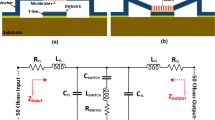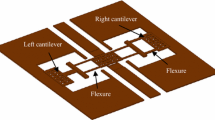Abstract
Micro electromechanical system (MEMS) shunt capacitive switches behave chiefly as a capacitor at both up and down states. Therefore, input-output matching for these switches is affected by varying the frequency. Although increasing the amount of capacitance at the up state reduces the actuation voltage, it deteriorates the RF parameters. This paper proposes a remedy for this problem in the form of two short high-impedance transmission lines (SHITLs) which are included at both ends of the MEMS switch. The SHITLs are implemented through adoption of a discontinued CPW transmission line. With this implementation, the switch can be modelled as a T circuit, neutralizing a capacitance behavior of MEMS switch at the up state. The paper also proposes an optimised fabrication process to realize a flat and planar bridge for the suggested RF MEMS switch. The measurement recorded by SEM and AFM shows that the proposed method significantly improves the planarity of the membrane. The RF and mechanical parameters of the fabricated switch are evaluated by Vector Network Analyser and Laser Doppler Vibrometer. At the up state, the switch has a return loss less than −20 dB in the entire frequency band (C-K). The isolation at the down state is better than 10 dB for the lower frequencies and increases to values better than 18 dB for the higher frequencies. The measured pull-in voltage is almost 20 V and the mechanical resonance frequency is 164 kHz.
Similar content being viewed by others
References
Rebeiz GM (2003) Rf mems switches: status of the technology. In: 12th international conference on TRANSDUCERS, solid-state sensors, actuators and microsystems, 2003, vol 2. IEEE, pp 1726–1729
Rebeiz GM, Entesari K, Reines IC, Park S-J, El-Tanani M, Grichener A, Brown AR et al. (2009) Tuning in to rf mems. IEEE Microw Mag 10(6):55–72
Daneshmand M, Mansour R (2011) Rf mems satellite switch matrices. IEEE Microw Mag 12(5):92–109
Scuderi A, Ragonese E, Palmisano G (2009) 24-Ghz ultra-wideband transmitter for vehicular short-range radar applications. IET Circuits Devices Syst 3(6):313–321
Caratelli D, Massaro A, Cingolani R, Yarovoy AG (2012) Accurate time-domain modeling of reconfigurable antenna sensors for non-invasive melanoma skin cancer detection. IEEE Sensors J 12(3):635–643
Van Spengen W (2012) Capacitive rf mems switch dielectric charging and reliability: a critical review with recommendations. J Micromech Microeng 22(7):074001
Rebeiz GM (2004) RF MEMS: theory, design, and technology. Wiley
Jaibir S, Nagendra K, Amitava D (2012) Fabrication of low pull-in voltage rf mems switches on glass substrate in recessed cpw configuration for v-band application. J Micromech Microeng 22(2):025001
Yu A, Liu A, Zhang Q, Alphones A, Zhu L, Shacklock A (2005) Improvement of isolation for mems capacitive switch via membrane planarization. Sensors Actuators A Phys 119(1):206–213
Soulimane S, Casset F, Charvet P-L, Maeder C, Aïd M (2007) Planarization of photoresist sacrificial layer for mems fabrication. Microelectron Eng 84(5):1398–1400
Villeneuve C, Pons P, Puyal V, Plana R (2010) Planarization optimization of rf-mems switches with a gold membrane. J Micromech Microeng 20(6):064013
Chan K, Ramer R (2010) A novel rf mems switch with novel mechanical structure modeling. J Micromech Microeng 20(1):015031
Kim C-H (2012) Mechanically coupled low-voltage electrostatic resistive rf multithrow switch. IEEE Trans Ind Electron 59(2):1114–1122
Park J, Shim ES, Choi W, Kim Y, Kwon Y, Cho D-I (2009) A non-contact-type rf mems switch for 24-ghz radar applications. J Microelectromech Syst 18(1):163–173
Herrmann CF, DelRio FW, Miller DC, George SM, Bright VM, Ebel JL, Strawser RE, Cortez R, Leedy KD (2007) Alternative dielectric films for rf mems capacitive switches deposited using atomic layer deposited al 2 o 3/zno alloys. Sensors Actuators A Phys 135(1):262–272
Koutsoureli M, Adikimenakis A, Michalas L, Papandreou E, Stavrinidis G, Konstantinidis G, Georgakilas A, Papaioannou G (2014) Comparative study of aln dielectric films electrical properties for mems capacitive switches. Microelectron Eng 130:69–73
Wong WS, Lai CH (2009) Longer mems switch lifetime using novel dual-pulse actuation voltage. IEEE Trans Device Mater Reliab 9(4):569–575
Makasheva K, Despax B, Boudou L, Teyssedre G (2012) Dielectric layers for rf-mems switches: design and study of appropriate structures preventing electrostatic charging. IEEE Trans Dielectr Electr Insul 19(4):1195–1202
Mafinejad Y, Kouzani A, Mafinezhad K, Mashad I (2013) Review of low actuation voltage rf mems electrostatic switches based on metallic and carbon alloys. Journal of Microelectronics, Electronic Components and Materials 43(2):85–96
Pozar D (2005) Microwave engineering (3rd ed.). Hoboken, NJ: Wiley.
Mafinejad Y, Kouzani A, Nassabi M, Lim Y, Mafinezhad K (2015) Characterization and optimization to improve uneven surface on mems bridge fabrication. Displays 37:54–61
Mulloni V, Giacomozzi F, Margesin B (2010) Controlling stress and stress gradient during the release process in gold suspended micro-structures. Sensors Actuators A Phys 162(1):93–99
Tung RC, Garg A, Kovacs A, Peroulis D, Raman A (2013) Estimating residual stress, curvature and boundary compliance of doubly clamped mems from their vibration response. J Micromech Microeng 23(4):045009
Yu A, Liu A, Oberhammer J, Zhang Q, Hosseini H (2007) Characterization and optimization of dry releasing for the fabrication of rf mems capacitive switches. J Micromech Microeng 17(10):2024
Acknowledgments
This work was performed in part at the Melbourne Centre for Nanofabrication (MCN) in the Victorian Node of the Australian National Fabrication Facility (ANFF). The authors acknowledge Dr Sharath Sriram and the Functional Materials and Microsystems Research Group at RMIT University.
Author information
Authors and Affiliations
Corresponding author
Rights and permissions
About this article
Cite this article
Mafinejad, Y., Kouzani, A., Mafinezhad, K. et al. Low insertion loss and high isolation capacitive RF MEMS switch with low pull-in voltage. Int J Adv Manuf Technol 93, 661–670 (2017). https://doi.org/10.1007/s00170-017-0558-9
Received:
Accepted:
Published:
Issue Date:
DOI: https://doi.org/10.1007/s00170-017-0558-9




